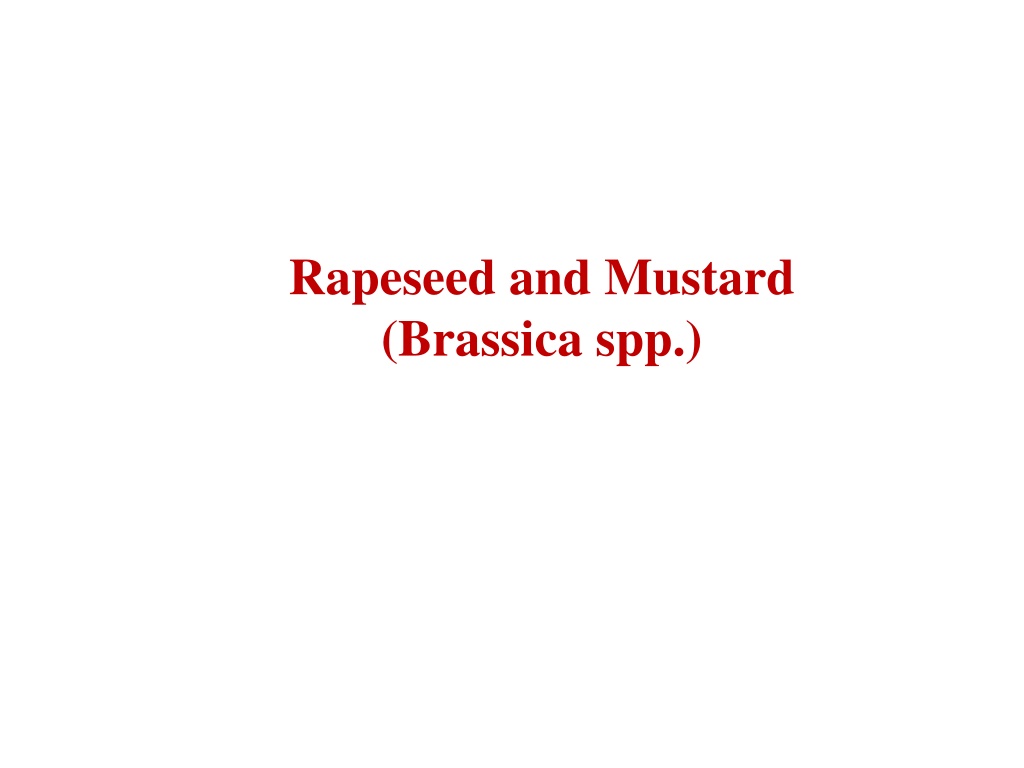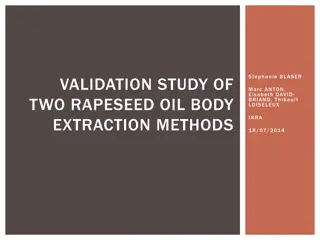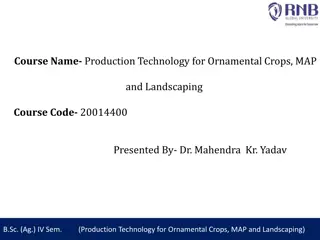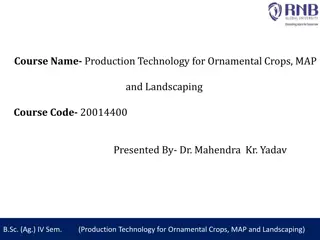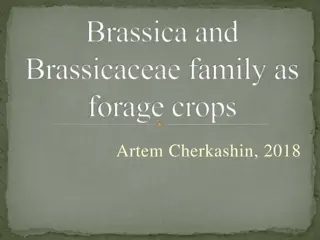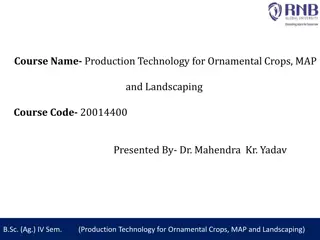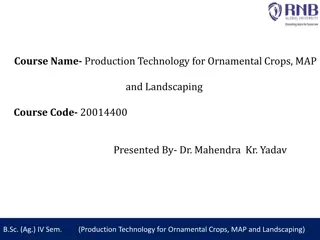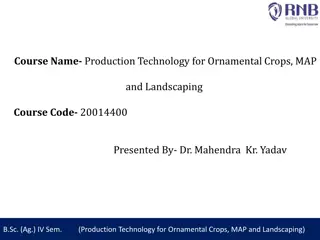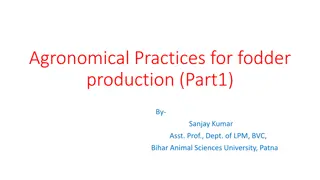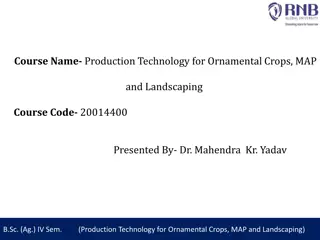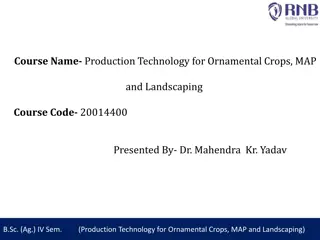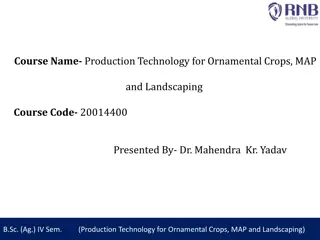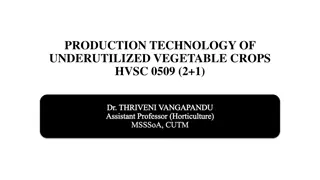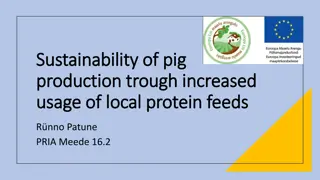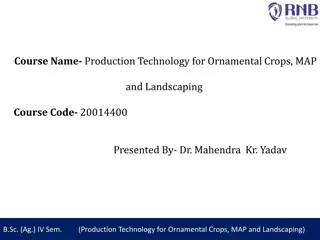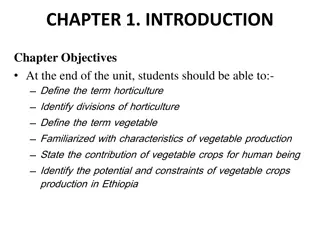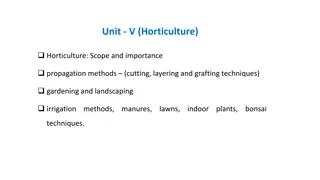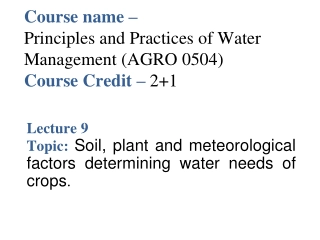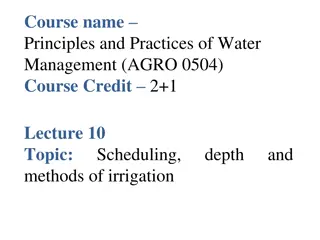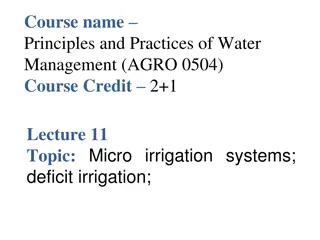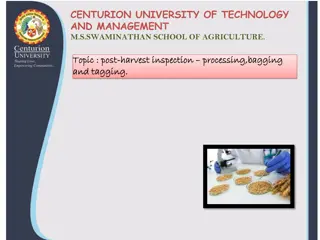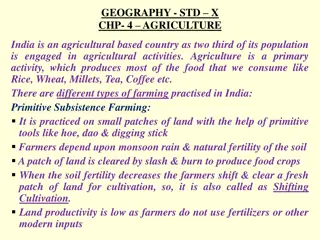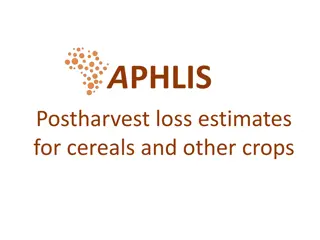Understanding Rapeseed and Mustard Crops: A Comprehensive Overview
Rapeseed and Mustard, belonging to the Brassica genus, are essential crops with versatile uses, especially in oil production. The various species and classifications, along with their origins and culinary significance, highlight their importance in agriculture and food industries globally.
Download Presentation

Please find below an Image/Link to download the presentation.
The content on the website is provided AS IS for your information and personal use only. It may not be sold, licensed, or shared on other websites without obtaining consent from the author. Download presentation by click this link. If you encounter any issues during the download, it is possible that the publisher has removed the file from their server.
E N D
Presentation Transcript
Rapeseed and Mustard (Brassica spp.)
Rapeseed and Mustard Rape seed and mustard are the different crops of same genus Brassica of the family cruciferae are mostly annual and some of them are biannual and rarely perennials. Rapeseed oil is obtained from the seds of several species of Brassica, and the oil from different species is not distinguised in the market, since, all have similar properties. The oil seed brassica comprises 4 species. 1. B. compestris (B. rapa) 2. B. juncea (Indian mustard) 3. B. napus (winter/spring rape) 4. B. carianata (Ethiopian mustard). Precisely rape seed and mustard is name used for oilseed obtained from 3 important genera i.e. Brassica, Eruca, Synapsis belonging to the tribe Brassicae. Of all the 3 genera, Brassica is the most important group of oil seed, it stands second after groundnut contributing nearly 25-30% of oil seed production in India. The genus Brassica comprises 37 species mainly annuals and biennual many of them are similar in appearance but B. rapa is the most variable and important in brassicae species.
The word Rapeseed is derived from Latin name rapa or rapum representing the seeds of turnip. As the mustard and other species of Brassica looked like turnip, the seeds of such crop were called rapeseed.
General Rapeseed and mustard is a group of crops, whose oils are similar in respect of their composition and human consumption. It is an important edible oil throughout the world, and In India, consumption of mustard oil is maximum among edible oils. Oil is also used for other applications (soap making, lamping and lubrications). Internationally, it is also known as canola. In many European countries, it is converted as diesel. Mustard meal (after oil extraction) is a popular cattle feed: Mustard plant is consumed as vegetable in china and parts of India.
Classification Eight species of Brassica and one species of Eruca are popular for mustard oil. They are: 1. Indian Mustard (Brassica juncea L.), commnly called rai (raya or laha) and its variation Rugosa commonly called Pahari rai 2. Indian Rape Toria/ Lahi (Brassica campestris sp. Olifera) 3. Black mustard (Brassica nigra) commonly called as Banarasi rai 4. Indian rape Yellow sarson (Brassica campestris) 5. Indian rape brown sarson (Brassica campestris) 6. Swede rape or gobhi sarson (B. nupus L.) 7. Ethiopian mustard or karan rai (Brassica carinata Braun.), 8. White sarson (Brassica alba) commonly called uji sarson 9. Taramira or Tara (Eruca sativa Mill.) is also grown for oil, popularly included as mustard oil. But native species B. juncea, B. campestris L. and exotic B. napus L. are the important source of edible oil than other species
Origin B. campestris and B. juncea (sarson, mustard and toria)-Western part of the Indian subcontinent (Afghanisthan); B. nigra Eastern Europe; B. napa Southern Europe; B. carinata Ethiopia; Eruca sativa Eastern Europe.
Difference between Sarson, Toria and Mustard Seeds of Sarson are smooth, bold, round, brown or black; seeds of Toria are reddish brown, smaller and ovoid/ spherical having slightly wrinkled surface; seeds of mustard are smaller than Toria, brown or black in colour and ovoid in safe having wrinkled surface.
Differences between sarson and Toria Sarson Toria Lower leaves and lower part of the stem are hairy with thin leaves Leaves and stem glabrous, leaves somewhat fleshy Dark coloured, mucilaginous seeds Matures atleast 1-2 months later than toria It is sown in october/November and harvested in March/April as rabi crop Light coloured, non- mucilaginous seeds Matures 1-2 months earlier than sarson It is a late kharif season crop, sown in september and harvested in December It is used as oilseed, fodder, vegetable oil and preferred for culinary purpose Grown for oil purpose; plants are not good for vegetable purpose
Differences between Yellow and Brown Sarson Yellow Sarson Dark, glaucous, fleshy leaves Thick and broad pods Dingy white or yellow, non mucilaginous seeds Late maturing Brown sarson Pale, glaucous, thin leaves Thin and narrow pods Dark brown, brown or reddish brown, mucilaginous seeds Early maturing
Botanical differences between sarson/toria and mustard Sarson/toria are less tall than mustard. They have sessile leaves clasping the stem partly, while mustard leaves are pinnatified and do not clasp the stem; sarson/toria are less branched than mustard; fruits (siliqua) of sarson/toria have stouter and laterally compressed with less prominent beak, but fruits of mustard are thinner with prominent beak.
Botanical classification: Scientific name Chromosome number Common name 2n=36 Indian mustard/Brown mustard/Leaf Brassica juncea mustard(Rai/raya/laha) B. rapa var Trilocularis 2n=20 Yellow sarson B. rapa var sarson 2n=20 Brown sarson B. rapa var dichtoma 2n=20 Toria Eruca vericaria sp sativa 2n=22 Tara/ Taramira Rocket salad, Raquette Abysinian mustard/Egyptian mustard 2n=34 B. carianata 2n=16 Black mustard/True mustard B. nigra B. napus sp olifera var annua 2n=18 Ghobi sarson B. alba syn Synopsis alba White mustard B. hirta
Botony: Rape seed and mustard include annual herbs ranging in height from 0.45 m in some varieties of toria to 1.75 m in yellow sarson. Roots in general are long and taparing. Toria is more or less surface feeder where as brown sarson has long roots with limited lateral spreading equaling of its successful cultivation in dryland conditions. Yellow sarson has both extensive root depth and lateral spread. In toria and B. Sarson branches arrise at an angle of 30 to 400C. Where as in yellow sarson branching is much close and arrise at 10-200 C and it will give a plant narrow and piramidal shape. Inflorescence in rape seed and mustard is corymbose receme. In yellow sarson 4 petals are spread apart whereas B. sarson and toria petals may overlap/spread apart. Flowers are hypogyneciouc syncarpus ovary. In B. sarson and toria ovary is bicarpillary, but in yellow sarson- tri/tetra carpillary. Fruit is called as siliqua. Pods are either 2/3/4 valved depending on number of carples in ovary. Flowers begin to open at 8 AM and continue up to 12 noon.
Physiology and Ideotype concept: First proposed by Donald (1963) in cereals but later on extended to other crop. Thurlig (1991) proposed ideotype in mustard. Brassica is energy rich crop with 25.7 mj/kg of seed. Yield is acheived with greater plant size and profuse branching. Dry matter production increases after the anthesis can contribute substantially to seed development. Sufficient biomass accumulation prior to flowering is pre requisite for better development of seed. Harvest index ranges from 0.23 to 0.29 and is positively correlated with yield. LAI of 3.5 to 4.0 between 6th and 8th week of crop growth is a major determinant of yield.
The ideotype concept is based on 1. Leaf inclination 2. Leaf size, shape and thickness 3. Apetulous flowers 4. Optrimum time of flowering 5. Dense upright pod canopy to allow more interception of light 6. Higher pod length to accommodate more seeds 7. Shattering resistance 8. Canola type seed quality. Upright and large pods permit 30% more light in canopy structure with increase pod number, seed/pod and seed weight. Dense pod canopy forms major source of C assimilates after flowering. Hence it is postulated that improvement in yield is possible highest light interception is achieved through pod canopy. Pod canopy should be held on branches at 70-800 angle. Higher pod length is also associated with greater number of seeds and high test weight. Yield parameters of pod number, seed/pod, seed weight are positively correlated with yield. Whereas number of seeds and seed mass is positively correlated, oil content and seed yield is negatively correlated, protein and oil is negative correlated. Yield is negatively correlated with duration due to competition for same limited sources of C and N. These characters can contribute marked increase in yield. Siliqua should posess more than 50% of pod weight to avoid shattering. Each siliqua should contain 15-40 seeds weighing 5 mg. Each pod should be long and narrow to have more light interception.
Soil and climatic requirement: Grown on wide range of soil. Alluvial soils both in entisols and inceptisols soils. MP, Karnataka grown in black cotton soils. However sandy loam and loamy soils with moderate organic matter content are highly suited for rape seed and mustard. It can also be grown on red soil (Alfisols) provided crust formation is managed. In countries like China volcanic ash soils are put for rape seed cultivation and these soils are called as Trumao soil. It does not withstand water logging particularly in seedling emergence and vegetative stage. Rape seed and mustard prefer normal pH but have capacity to tolerate alkalinity but not salinity. Raya is suitable to grow on all type of soils. Toria performs best on loam to heavy soils. Sarson and Taramira perform well in very light soils. Oil seed brassica are well adopted to cold moist temperate climate and it requires fewer heat units compare to soybean and sunflower. In tropics, it grown at higher elevation of 1000m and prefers moderate temperature of 25-280 C but optimum temperature is 200C.
Seed oil content increases when grown at 10-150 C but 40 C are highly harmful to crop. It has been shown that crop is clod tolerant and hardened plants can withstand -400C. Frost adversely affect flowering, pollen development, viability of seed. Frost at maturity reduces oil quality and make it unfit for consumption. In general, frost affected plant will have low oil content. Bright sunshine hours of 10 hours or more is required for its cultivation. Shading reduces number of pods, number of flowers and pod size. Rape seed and mustard grow well in areas receiving annual rain fall of 250- 400 mm. Mustard and toria are grown in on medium to heavy rain fall areas. Yellow sarson, brown sarson, taramia in low rain fall. Cloudy sky and RH of more than 80% is not desirable because it attracts aphids and other diseases.
Varieties: Adoption of improved varieties can increases yield up to 15-20%. Growing states Punjab, J&K, Haryana, Species Toria Varieties TL-15, PBT-37 N. Rajasthan Mustard RH-30, Laxmi, RLM-619, CS-52, Geetha, Karan rai Kranthi(RK9807), Maya (RK9902), Swarna jyothi (RK 9801), RGN-48, VAsundhara (RK9304), RL- 9927 GSL-1, Hyola-401,GSL-2 Gaubi sarson WB, UP, MP Toria Yellow sarson Bhavani, PT303, PT307 Ragini Mustard Jagannath, Rohoni, Varna, Urvashi, Vasundara, Aravati. Kiran, Pusa swarnim Karanra AP, TN, Karnataka Mustard Pusa agni, GM-2, JM_1, Varda, Varna.
Area and distribution Grown in 53 countries over 34 million hectare producing 65 million tons. Main producers are and China as well as France and Germany. Productivity varies from 411 kg to 6200 kg/ha. In India, different types of mustard and rapeseeds are grown in the states of Haryana, Punjab, Uttar Pradesh, Bihar, Rajasthan, Odisha, Himachal Pradesh, Madhya Pradesh, West Bengal as well as many North Eastern states, at an average productivity of 1370 kg/ha.
Soil and climatic requirements It is typical cold loving crop. requiring a temperatures of 15-25 C. Germinates better at around 23-25oC, but requires low temperatures of 15-20 C for later growth. At maturity, temperatures up to 28 C are tolerable, frost or minus temperatures are undesirable. Toria are more sensitive to cold temperatures than sarson and mustard. Cloudy weather, frost, high humidity are undesirable during fowering/fruit development. In heavy soils, grows in rainless condition, but in sanay sols, showers are desirable. Best grown in alluvial, clay loams, sandy loams and terrai soils with good wuter holding capacity and slightly alkaline pH (7-8).
Cropping system Toria is grown under rainfed and irrigated systems as a sequential crop, while sarson and mustard are grown as rainfed crop, sometimes with intercrops like gram, potato, Ientil, wheat, etc.
Sowing: It is done by drill, in a finely prepared seed bed., using -6 kg seeds/ha (sole crop) or 1.5-2 kg seeds/ha (intercrop) 45 cm rows (in case ot toria 30 cm); season sarson and mustard in first fortnight of October (in Punjab up to November end) and toria in first fortnight of September.
Land preparation: Is a small seeded crop therefore clody seed bed is not suitable. Crop grown in rabi season on stored moisture condition and clods result in evaporation of soil moisture, it also make way for entry of saw fly/painted bug. In irrigated areas first ploughing is done by medium size mould board plough with 2-3 harrowings with cultivator. Planking is must after every ploughing. In rainfall areas one are two ploughings with desi plough/cultivator is done followed by planking. Deep ploughing in summer results in loss of soil moisture particularly in rainfed condition. Toria particularly requires fairly moist seed bed for good germination but excess moisture should be avoided.
Date of sowing: Sowing time of rape seed and mustard begins in India from end of August and continue up to end of November. In Rajasthan, Haryana, UP and Punjab where it is grown as catch crops between summer crop and wheat crop. Sowing starts at the end of August and ends in mid November in NE states. Early to mid September is most accepted seeding time of this crops. In WB, Assam, Orissa, Bihar crop is sown in mid October to mid November. Middle of October when temperature is 24-260C is considered as ideal for sowing. Study at IARI showed that all brassica sp yield lower yield when planted at November compared to October due to delayed sowing. Taramira can be sown up to 5th November. Late formed flowers develop pods with flower and lighter seeds and affect final seed yield. Delayed sowing also results in lower oil content in most brassica spp. Further late sown crop is more susceptible for attack of insects and aphids.
Plant population and spacing: Brassica are very sensitive to weather variation. Therefore establishment of optimum plant population ranging from 2.5-3 lakh plants per hectare or 25-30 plants/m2 often become difficult. Allowing a margin for poor seed germination seed rate of 3.5-10 kg/ha has is been used in different states of India. Under dry land conditions, germination percentage is very low i.e. 33% and such situation if test weight is 3g then use 4kg/ha. If test weight is 4-5g then use 5-6kg/ha. In case of toria, brown, yellow sarson and taramira the desired plant population can be attained by thinning seedling at 15 and 25 DAS. Except for toria and mustard for all ideotypes spacing is 30x10cm. But for Toria 30x22cm, 35x 10 cm is practiced in UP, MP, Gujrath, Punjab.
Seed treatment: Seeds should be treated with Bavistin @ 2g/kg seed or Brassica/Captan @ 4g/kg seeds is used to protect diseases like root rot and sclerotia disease. Apart from the treatment, to ensure early viguor the seed should be soaked in water/dihydrogen sodium solution @ 358g for 4 kg seed. Soaking in water for 4 hours should be followed by shade drying. The seeds should be soaked in slurry of dithane M-45 @ 2g/250 ml of water for 1 kg of seeds for 4 hours and it should be shade dried. Soak the seeds with moist soil and keep it for overnight and sown along with soil.
Fertilizer recommendation: Manures and fertilisers: 3-5 t/ha manure. Nitrogen 80 kg (rainfed) and up to 120 kg ha (irrigated): Phosphorus 30 40 kg/ha and potassium 20-30 Kg/ha. N splits. Oil seed brassica is considered to be heavy feeder. They remove 80-131 kg N, 17- 26 kg P, 70-133 kg K along with 26-45 kg S. Sulphur requirement is double than P requirement because the rape seed and mustard produce Glucosinolate @ 100 micro moles per gram of seed. This is important for development of characteristic flavor. Sulphur needs of brassicae is usually higher nearly take twice that of P and compare to other oil seed crop. Oil seed brassica remove secondary nutrients (Ca=29-63 kg/ha, Mg=13-19 kg/ha, Fe=1062-1684g/ha, Mn=143-338g/ha, Zn=117-334g/ha, Cu=25-43g/ha.)
Response to fertilizer application: Brassica respond well to nitrogen fertilizer even under dryland condition up to 30- 50 kg N/ha. It is optimum for mustard and toria. Rate can be increase to 40-60 kg under assured rainfall condition. In drylands there is a very positive and significant responses up to 20 kg N/ha with increase in 13.6 kg grain/kg N. In irrigated condition it can respond up to 120 kg N /ha with increase in 11 kg grain per kg N. Response to P, depends on soil P status, moisture and yield level attains. The proliferation of N:P is applied in 2:1. Recommendation: Bharatpur = 30-30-20 kg NPK/ha Alwar, Ajmer = 60-40-20 kg NPK/ha UP=mustard- 80-40-40- Irrigated condition, 60-40-20-rainfed condition. UP=60-40-40=Irrigated condition, 40-20-20- rainfed condition for yellow/brown sarson
Important source of Sulphur: 1. SSP-12% S, Gypsum-18% S, Pyrites-20-50% S. When adequate P is applied as SSP, an S need of crop is taken care. When pyrites are applied it should be applied 3-4 weeks before sowing because solubility of a Iron is slow. Interaction of nutrients: There is a synergistic interaction observed between NxS and KxS. whereas antagonistic interaction between PxS and MgXS. Constituent of protein and other organic compounds: Mutual regulation of N and S to transport plant even reduction of NO3 to NH4 and SO4 to SH3/H2S it mechanism.Adequate N to S ratio should 7.5:1 in grains, 11-12:1 in leaves. According to AICRP in oil seed crop. It wasfound that Zn at 10 kg/ha along with B with 2 kg/ha and S with 20 kg/ha increases higher yield. takes place through similar
Weed control: Critical weed competition up to 30-40 days, Weed control by inter cultivations and hand weeding up to 40-45 DAS. Pre-emergence herbicide Nitrofen @1-1.5 a.i./ha or isoproturon @l kg a.i./ha.
Irrigation: Consumptive use of water is 200-300mm and mustard benefit by one or two irrigations, one at pre flowering stage and two irrigations at first at rosette stage (20-30 DAS), 2nd at siliqua formation stage (50-60 DAS). Particularly toria and sarson yield increase with one irrigation in toria and yellow sarson in 10-30%
Cropping systems: Rape seed and mustard grown in solid stand and mixed stand few varieties of brassicae PR-43, RH-30, Varede are well suited for cropping systems. Wheat+ Mustard (9:1)- Almost in all mustard growing areas. Chick pea + sarson (3:1)-UP, Haryana, Rajasthan. Potato+Mustard/Yellow sarson (3:1)- UP. Sugarcane+Mustard/Toria (1:1- UP, Haryana, Rajasthan. Toria + Ghobisarson (1:1) Toria + Lentil (1:1)
Crop sequence: Bihar- Maize-Mustard MP- Fallow-Muatard Rajasthan- cowpea/Mung bean/Urd bean/Cowpea- Mustard. Eastern UP- Maize/Rice/ sesamum-Mustard Central UP- Maize-mustard Western UP- Sorghum-Mustard. Fallow/Sorghum/Maize/Pearl millet
Disease: Alternaria blight-Albigo candida Downey mildew- Peranosporum parasitic Sclerotinia rot- Erysipha cruciferous Seedling rot- Sclerotinia rolfisi Phyllody- Virus Management: Using of resistant varieties and escape mechanism like timely sowing, early maturing variety, crop rotation, burning of debris, seed treatment. Foliar diseases: Seed treatment with metalaxyl (Apron) 35 DAS @ 0.2%, Ridomil MZ 72WP @ 0.2%, 2 to 3 spray at 15 days interval. Seed treatment with radomil spray at severe disease
Insect and pest: Aphids cause 69-96% yield loss in sarson and 27-69% in mustard. If it is severe by end of December and up to January spray Metalaxyl 25 EC @ 1ml/100 lt, Phosphomidon 100 EC @ 300 ml/100 lt, spray 2-3 times at 10-15 days intervals. Spraying should be done in after November to avoid damage to the honey bees.
Harvesting When the siliqua tun yellow or brown, the entire plant is cut and left in the field for 5-6 days and then beaten up and winnowed in slow moving air.
